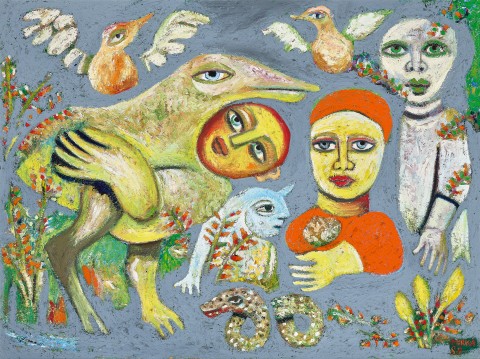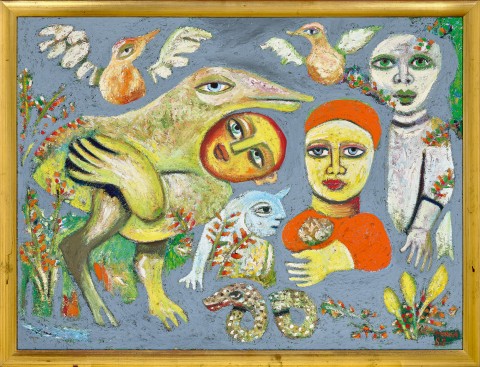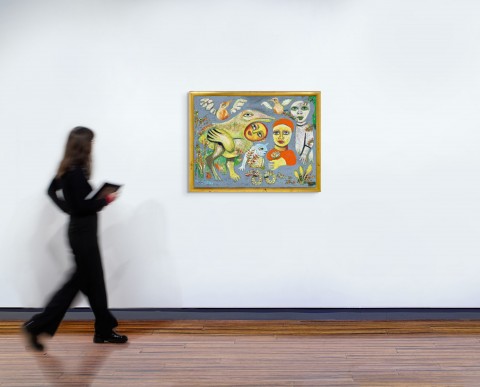(1928 - 2018)
Mirka Mora
The wedding, 1988
oil on canvas
William Mora Galleries, Melbourne (stamped verso)
Private collection, Melbourne, acquired from the above in 1992
Mirka Mora - Recent Paintings, Willliam Mora Galleries, Melbourne, April 1992
Flanked by a pair of doves and surrounded by boughs of wildflowers, Mirka Mora’s hybrid woodland creatures appear joined in a mysterious ceremony within this painting inflected with the otherworldly, medieval quality of a fairytale. The wedding, 1988, was created during the second chapter of Mora’s colourful artistic career, at a time following the dissolution of her long marriage to Georges Mora, when her identity as an independent multimedia artist found its full form and her idiosyncratic oeuvre began to be celebrated. Although a treasured catalysing figure of the Melbourne art scene since the 1950s, Mora’s contribution to the development of Australian modernist art is still to be fully recognised.1
Bursting with generosity and joie de vivre, Mora’s art reflected the ebullient nature of its creator. Born in Paris in 1928 to parents of Lithuanian and Romanian Jewish heritage, Mora was sent to an internment camp alongside her mother and two sisters, only surviving the Holocaust by hiding in the forest of the French countryside. Barbara Blackman later wrote that Mora emerged from this experience ‘a mistress of invention untainted by formal education.’2 In a 1979 interview with the Australian Broadcasting Company, Mora claimed that her ‘brain got stuck’ at that tender age.3 Memory became a defining leitmotif of Mora’s paintings, drawings and textile works, endowing them with a disarming innocence and strong autobiographical register. From her first charcoal drawings in the 1950s, a celebration of love and family life has been a central theme of Mora’s artistic vision. The whimsical tableau presented in The wedding includes wide-eyed figures of her personal iconography co-existing with fantastical creatures, the magical powers of the forest providing them all with protection.
Although Mora resisted attempts to analyse her works, her simple, self-taught forms are underscored by a strong literary foundation and informed by a vast and intriguing array of sources. Possibly drawing on the legacy of French Surrealist interest in automatic drawing and the unique visual vocabularies of folk art and Art Brut, Mora’s expressive figuration was most profoundly shaped by her interaction at Heide with Arthur Boyd, John Perceval and Joy Hester. Like Arthur Boyd within his series Love, Marriage and Death of a Half-Caste, Mora uses allegorical imagery to present marriage as a surreal process of transformation and metamorphosis.
Mirka Mora’s anthropomorphic creatures and human avatars are depicted with bright, saturated tones. Boldly outlined, their flat shapes seem to float in the shallow and monochromatic space. Paying homage to her Eastern European heritage, these folkloric figures are arranged in a frieze that becomes almost sculptural in the physicality of its paint. This monumental narrative effect is likely an outcome of Mora’s extensive production of large-scale murals throughout the 1970s, which enduringly wove her whimsy into the quotidian visual fabric of Melbourne. Patrick McCaughey provided counsel for the public’s interpretation of Mora’s unique visual offering: ‘… [Mirka’s] fantasies are not a way of escaping from the world but a way of participating in it. They redeem it from its mundanity, transforming it into a magical zone… a bright world to enter and difficult to leave…’4
1. Morgan, K., "Mirka Mora" in N Bullock, K Cole, D Hart & E Pitt (eds), Know My Name, National Gallery of Australia, Canberra, 2020, pp. 260–261
2. Blackman, B., 'The good ship Mora: Melbourne in the 1950s’, Meanjin, vol. 2, 1996 (winter), pp. 293-305
3. Reich, H., ‘Mirka Mora: From Holocaust survivor to the matriarch of Melbourne's art scene, an incredible life on display in exhibition’, The Art Show, ABC, 14 March 2021
4. McCaughey, P., ‘Fantasy key to the world’, The Age, Melbourne, 7 June 1967, p. 8
LUCIE REEVES-SMITH


